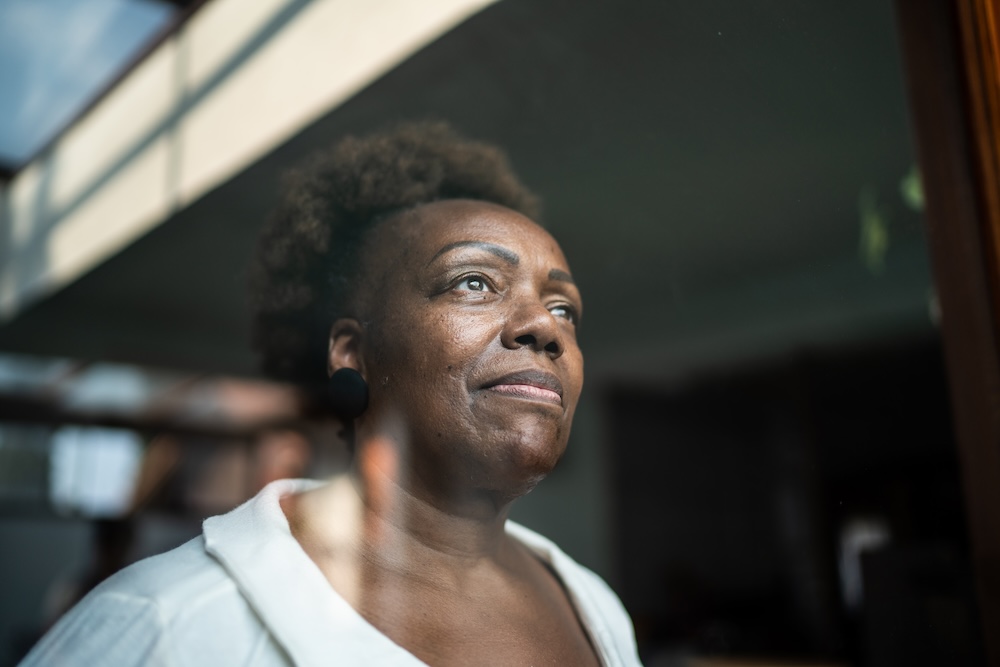When you’re feeling anxious and the walls are closing in, it’s pretty hard to resist wrapping yourself into a duvet sausage roll, burying your head beneath the covers and waiting for the emotional wave to pass. Sometimes, that is exactly what is needed, but did you know menopause and exercise can really impact how you feel?
Find what you need quickly
Is there evidence to prove exercise works for anxiety?
I saw a great meme the other day. It said: “When you are feeling super low, you can guarantee that someone in a live, laugh, love t-shirt will pipe up and ask if you’ve been outside!” It is excruciatingly irritating when your nerves are jangling and you feel out of sorts to be told to get out into nature, get your blood pumping and feel the fresh air. But what if there really is something in menopause workouts impacting how you feel?
Dr Lucy Wilkinson, a GP with special interest in women’s health, explains: “The people in the live, laugh, love t-shirts are on to something! Studies have shown that exercise really can improve anxiety symptoms, with the same effect being demonstrated specifically in midlife and older women. Exercise has also been shown to improve depression as well as being good for your overall health.”
Learn more about anxiety, depression and panic attacks in our symptoms library.
What exercise does to your body’s hormones
- Exercise reduces levels of the body’s stress hormones, such as adrenaline and cortisol
- It stimulates the production of endorphins, which are the body’s natural painkillers and mood elevators
- Women who are physically active report better sleep quality and a decrease in sleep disturbances
- Sleep and mood are linked – improving your sleep will also help balance and boost your mood
Dr Lucy says: “Endorphins are sometimes called ‘nature’s painkillers’ – they even get their name from a combination of the words ‘endogenous’ and ‘morphine’. As well as increasing your pain threshold, they can produce a sense of euphoria and ease anxiety. Endorphins are released when we exercise, which explains how physical activity can ease anxiety symptoms.
“Add to that the fact that exercise gives us an opportunity to practice mindfulness (whether consciously or not) and contributes to our physical wellbeing and it’s easy to see why this is a vital part of our positive mental health toolkit.”
Read Ida’s story on exercise and menopause, and how walking helped her manage dark thoughts.
Does this mean intensive gym sessions?
Not necessarily. You don’t need to go sweating it out at a spin class to start reaping the calming benefits of exercise but cardio (aerobic or endurance training) is what you need to aim for to really help with your mood.
Dr Lucy says: “Anything that gets your heart rate up should do the trick. There are plenty of free and accessible activities that you can easily fit into your day, including brisk walking, gardening and housework. More intensive exercises – including running, cycling and swimming – are great too.
“The important thing is to find a type of exercise which you enjoy and will be able to stick to – consistency is key! Aim to do 150 minutes of moderate or 75 minutes of vigorous exercise per week. Stella has some low-impact workouts if you struggle to exercise due to joint pain.”
Exercise helps with your overall wellbeing too. It can be tricky to stick to an exercise routine, but it’s a great feeling to see your body getting stronger and healthier as the weeks go by.”
Best exercise for menopause anxiety
- Walking – This is a great way to get back into exercise and a good menopause workout if you walk briskly and pump your arms (think Nordic-style with ski poles!)
- Strength-training – You can find plenty of video inspiration on Stella to keep your bones strong when it comes to exercise and menopause
- Cardio – Download Stella for a variety of videos to follow. If you have joint pain or pelvic floor issues, it’s a good idea to look for low-impact versions
- Yoga – This builds strength and also helps you relax
Read more about the best exercise for menopause and how to get started.
How I went from deskbound to active in six months
I’ve felt off-kilter with weird moods during perimenopause, including a repeat ticket on a vile confidence rollercoaster, plus jetstreams of rage. It feels like I can chart my fluctuating oestrogen against the wild peaks and dips! Embroidery helped the anger and I began to exercise to improve my mood and overall wellbeing. Walking turned out to be the best exercise for menopause for me.
When I started being active, my exercise levels were at an impressively low 1,200 steps a day (hello, homeworking), as I shared in this post. Walking was uncomfortable and I was a bit breathless if talking and walking. Walking was never something I would have done for fun!
I began by walking after work and I increased to 3,500 steps. I slowly built up my walks to reach 5,000 steps and, before long, I was walking twice a day to get to 8,000 steps. After five months, I was averaging 10,000 steps (around 1.5 hours per day) and building in hills.
Keeping menopause exercise interesting
It’s now an automatic habit. I walk every day and I feel twitchy until I’ve gone for walk outside. I began to look at my active minutes instead of focusing on steps to try and get my heart rate up. I started to add in cycling and sea swimming.
I’ve gone from 22 mins per day (to reach the recommended 150 minutes of moderate exercise a week) to an average of 350 minutes each week. I even recently went for my first 2.5-hour cycle ride (we won’t mention that I fell off!).
How has this impacted my mood?
Over the six months, my sleep has improved from 5.5 hours a night, including being awake for an hour at 3am regularly, to an average of 7.5 hours a night. I still wake up but I can get back to sleep easily.”
I feel generally more optimistic, open to new experiences and have more happy days. When the difficult days appear, I just plod them out on a walk. No matter how bad I feel, I’ve never felt worse after going outside for my menopause workout.
Mind you, if anyone pops up in a live, love, laugh t-shirt to tell me to enjoy the fresh air when I am in misery, I might still lose it…
Final word
Dr Lucy says: “As well as having a positive effect on mental health, exercise helps you to maintain a healthy weight, increase muscle mass and ensure that your body processes sugar in a healthy way. It’s also great for heart and cardiovascular health. These are especially important points for women going through menopause, as the decrease in oestrogen levels seen at this time can affect all of these processes.
“If I could prescribe exercise in pill form, I would! As it is, there are no shortcuts. Build in exercise wherever you can and see how much of a difference it makes to you.”
Find out more about menopause and exercise on our blog.





